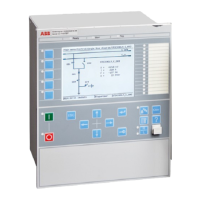7.1.3.2 Meshed network with parallel line
M12915-34 v6
In case of parallel lines, the influence of the induced current from the parallel line to the
protected line has to be considered. One example is given in figure
42 where the two lines are
connected to the same busbars. In this case the influence of the induced fault current from the
faulty line (line 1) to the healthy line (line 2) is considered together with the two through fault
currents I
fA
and I
fB
mentioned previously. The maximal influence from the parallel line for the
IED in figure
42 will be with a fault at the C point with the C breaker open.
A fault in C has to be applied, and then the maximum current seen from the IED (I
M
) on the
healthy line (this applies for single-phase-to-earth and two-phase-to-earth faults) is
calculated.
IEC09000025-1-en.vsd
~ ~
Z
A
Z
B
Z
L1
A B
I
M
Fault
IED
Z
L2
M
C
Line 1
Line 2
IEC09000025 V1 EN-US
Figure 42: Two parallel lines. Influence from parallel line to the through fault current: I
M
The minimum theoretical current setting for the overcurrent protection function (Imin) will be:
EQUATION82 V1 EN-US
(Equation 25)
Where I
fA
and I
fB
have been described in the previous paragraph. Considering the safety
margins mentioned previously, the minimum setting (Is) for the instantaneous phase
overcurrent protection 3-phase output is then:
EQUATION83 V2 EN-US (Equation 26)
The protection function can be used for the specific application only if this setting value is
equal or less than the maximum phase fault current that the IED has to clear.
The IED setting value
IP>>
is given in percentage of the primary base current value,
IBase
. The
value for
IP>>
is given from this formula:
EQUATION1147 V3 EN-US
(Equation 27)
Section 7 1MRK 511 358-UEN A
Current protection
104
Application manual

